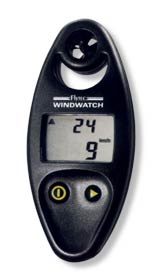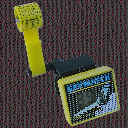






Back to Jérôme's Paragliding page / Aerodynamics.
AirSpeed Indicator (ASI) Types
2001/8/3.
The question :
Does air speed change (when measured with a wind meter)
when altitude, pressure or temperature changes ?
We are not interested in ground speed (or GPS trajectory speed),
just air speed.
Let’s take the case where one flies at sea level and measure a trim speed of 36 km/h. If he goes to a 10000’ mountain and flies off, will he see the same air speed on his wind meter ? Of course absolute (ground) speed will be higher because of the lower density.
Jon Goldberg-Hiller, 1999/6/14 :
It depends, in my estimation, on the type of wind indicator that you use.
“True Air Speed” will be shown by an impeller-type
indicator which will not be compensated by changing air pressure.
It will show the average speed of molecules rushing past and
spinning the impeller.
However, a tube-type indicator (or a pitot) will
give “indicated air speed” which compensates for
pressure change, temperature and the like. The pitot system measures
pressure and not molecular speed.
In lower pressures
(higher altitudes) it will need greater molecular speed to compensate for
a decreased number of molecules to measure the same
indicated airspeed.
This is similar to your wing that will fly faster at
10000' than at 0' for the same reason: less molecular density
and so a need for more molecules to provide the same amount of lift.
Rob McKenzie, 1999/6/14 :
There are airspeed measurements
called indicated, true and calibrated.
I am most familiar with true and indicated.
True is as it says... true based on how fast you move relative to
the actual air molecules.
Indicated airspeed is the most important one to us I think.
It is the force of the air.
The Hall windmeter is an example of an indicated ASI (airspeed indicator).
The little plastic floatie that rises inside the tube is lifted up by air drag.
Gravity pulls it down and the air rising forces it up.
It reaches a terminal speed of freefall.
The taper of the tube changes the speed of the rising air so the
faster the rise of the air, the higher in the tapered tube it goes to reach
it’s terminal falling speed.
If you were to measure at sea level, that you could go 20 mph brakes off with a
Hall ASI then you would get the same thing at any
altitude with the same instrument.
You see.. your wing with you in it IS an
indicated airspeed indicator.
Yes... you are flying a 250 square foot airspeed indicator set to show 20 mph
indicated airspeed (brakes off).
It is possible that at 18000’ msl that you
are actually going 40% faster (ie; 28 mph true airspeed,
just a guess) as measured
by a true ASI but with the Hall ASI it will still
read 20 mph.
It reads less because as you know already, the air is less dense and
it takes more speed to make the same force.
If you want to split hairs, you could say that you go slower indicated
at altitude because you are further from the earth and
therefore weigh less.
Less weight means less wingloading and less airspeed.
Then again, if you want to split it again,
being higher you displace less mass since
you have the same volume at all altitudes
(unless your head swells from being so excited about getting high that is)
and the air you displace at high altitudes weighs less
than at low altitudes.
You are always being floated in the air like the rock underwater
weighing less than out of the water.
So you might actually weigh less at lower altitudes.
Run those numbers for me will you,
I am curious at what altitude I should weigh
myself in the morning to get the lowest reading.
Jerome Daoust, 2001/1/28. Some Example...
|
|
|





|


|
Kevin Caldwell, 1999/6/14 :
Your true airspeed will increase by about 2% per thousand feet (density altitude)
over the indicated airspeed.
If you are at 10000', and the airspeed indicator reads 30 mph, you are actually
moving through the air at about 36 mph true airspeed,
neglecting instrument errors,
wing circulation, etc.
From Air Speed Indicators (ASI) by SKYSports
Flight Instruments - Air Speed Indicators (ASI)
There are several different types of ASIs. First is the pitot (pronounced pee-toe) or pressure type, the most popular. It compares the pressure generated in a pitot tube aimed into the air stream to the "static" pressure of undisturbed air. Static pressure is obtained through an opening in the instrument case which is shielded form the pressure created by the movement of air past the aircraft by an instrument panel or pod.
The venturi-type ASI works on the opposite principal to the pressure ASI. A vacuum is drawn from a venturi mounted in the air stream. The instrument measures the difference in pressure between the vacuum generated by air movement through the venturi and the static pressure. This type was developed in Germany for use in sailplanes, as the pressure (pitot) ASI may not be as accurate at low airspeeds. Its only drawback is that the venturi must be located reasonably close (maximum of 10 feet) to the gauge or the air chamber within the tubing connecting the venturi to the gauge will act as a buffer, reducing the instrument's accuracy.
Electrically operated ASIs use propellers mounted into the wind to sense airspeed and communicate the information to the gauge through a wire harness. There are three types:
$Free advice - Regardless of type of ASI, its pitot, venturi, or propeller must be positioned in clean, undisturbed air. No part of the aircraft, even a wire, should be in front of the sensor, and it should not be within six inches or so of the fuselage, if any. In the case of the venturi, no structural parts of the aircraft can be directly to the rear of the sensor either, as any interruption of the air flowing through the venturi can affect the vacuum and thus the air speed indication.
The placement of the ASI sensor is more of an art than a science. It is wise and time saving if the maker of the airframe is consulted for ASI sensor placement before installation.
The size of the opening in the end of the pitot tube is not critical, as no air is actually flowing through it. A straight pitot can be substituted, for example, for the "bubble pipe" type pitot supplied with Winter® ASIs if preferred. It can be made from any length, again not critical, of 1/4" diameter aluminum tubing or even automotive brake line. However pitots with larger openings seem to be more accurate at lower speeds and during large changes in the aircraft's angle of attack.
From FAR, Part 1--Definitions and Abbreviations
"Calibrated airspeed" means the indicated airspeed of an aircraft, corrected for position and instrument error. Calibrated airspeed is equal to true airspeed in standard atmosphere at sea level.
"Equivalent airspeed" means the calibrated airspeed of an aircraft corrected for adiabatic compressible flow for the particular altitude. Equivalent airspeed is equal to calibrated airspeed in standard atmosphere at sea level.
"Indicated airspeed" means the speed of an aircraft as shown on its pitot static airspeed indicator calibrated to reflect standard atmosphere adiabatic compressible flow at sea level uncorrected for airspeed system errors.
"True airspeed" means the airspeed of an aircraft relative to undisturbed air. True airspeed is equal to equivalent airspeed multiplied by (ρ0/ρ)1/2.
"CAS" means calibrated airspeed.
"EAS" means equivalent airspeed.
"IAS" means indicated airspeed.
"TAS" means true airspeed.
From The Description and History of Airplanes - Flight Instruments
The airspeed indicator operates by air pressure transmitted from the Pitot-static tube. Actually this is two tubes in one. The Pitot tube has an open end that protrudes from the wing, nose, or vertical stabilizer. It measures the impact of the airstream. The static tube is closed in front, but small holes in its sides supply it with still air. It measures the atmospheric pressure. The airspeed indicator is a hollow diaphragm connected to the Pitot tube. Its case is joined to the static tube. The Pitot pressure forces the diaphragm to expand or contract with the increase or decrease in speed. The difference between Pitot and static pressures is registered by levers and gears leading to a pointer.
The airspeed is indicated on the dial in statute miles or nautical miles (knots) per hour. The instrument registers true airspeed only in still air at normal atmospheric pressure. At different altitudes and temperatures the atmospheric pressure varies. The indicated airspeed (IAS) must be corrected to true airspeed (TAS) by adding 2 percent to the IAS for every 1,000 feet that the plane climbs above sea level.
Gary Brock, 2001/1/28 :
Indicated airspeed (IAS): Most simply - the airspeed indicated by the monitoring/sampling instrument. Indicated Airspeed is the raw uncorrected output/signal generated by any source of airspeed measuring device no matter how it is generated - impeller, ram or whatever. Unless your electronic whizgig you use has been programmed to automatically correct for manufacturing and installation errors, and non-standard temperature and pressure; what you are reading is simply indicated airspeed - no matter how it is generated.
Calibrated airspeed (CAS): Indicated airspeed corrected for instrument and/or installation error. The indicated airspeed is conditioned for manufacturing imperfections in the device that sampled/generated the raw signal, and/or for known installation errors when the sampling device was installed on the aircraft or PG'er in this instance. Now that this output/signal has been corrected/conditioned, we can now call it Calibrated Airspeed.
True airspeed (TAS): Calibrated airspeed corrected for non-standard temperature and pressure. Once the Calibrated Airspeed output/signal has been generated, it is then corrected for non-standard temperature and pressure. Standard sea level temperature and pressure are 15 degrees C., and 29.92 hg. respectively. We now have a signal/output to send to an indicating device that will now display; True Airspeed.
The biggest concern is CAS, as any sampling instrument can easily be 10 % off. While 10% of 23 mph is not that significant, (2.3 mph) it is not uncommon for these instruments to be erratic due to variances of impeller drag and imperfections in venturi surfaces. The best and most reliable source of indicated airspeed is a ram air pitot tube suspended or projected far beyond any lifting surface.